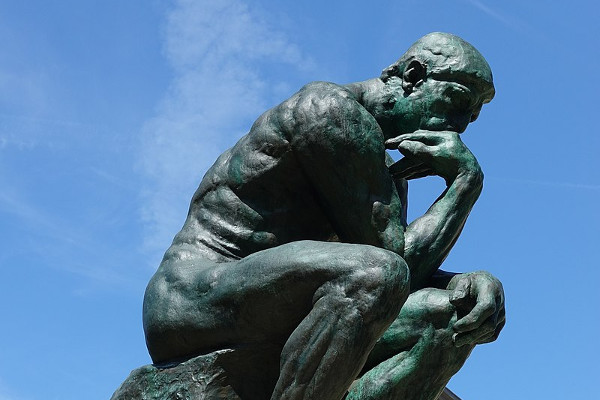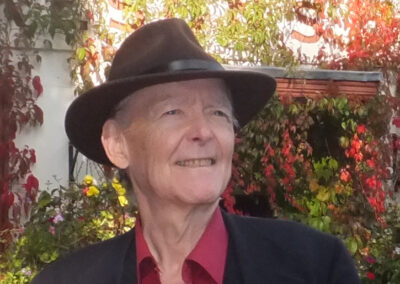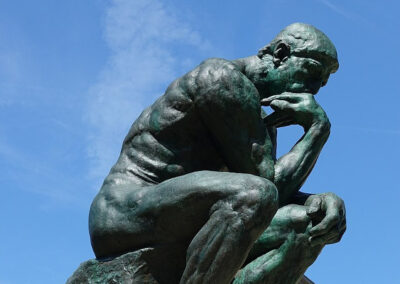This section considers specific experiments and theses that point up aspects of how belief-systems should be modified as a result of the recent findings in science. There is a huge reservoir of information about the latest scientific developments with more coming in all the time and it is not possible to do more than touch the surface of what is available.
Introduction:
The advance of science shows us that the seat of some emotions and thinking processes are circumscribed in their own locus in the body which is sometimes the brain and its two hemispheres or sometimes the heart, and so forth. What of the originating kernel or inspiration of it all? What of the detail? We see the world around us through our own lens or categorising framework and make sense of what we see in terms of our perceptions, and define these in linguistic terms. We think we know what they are. In the rough tool that is our language, we can talk of gradations of the primary emotions like ‘love’ or ‘anger’ though a quantification of them or talk of the strength with which they assail us largely eludes us, hence the efforts of poets to define their nebulous core. The question of what is located in this nebulous core has as yet no generally accepted answer and hardly a hypothesis to accurately explain it away. To say of it, for instance, that it is ‘not there’ or ‘nowhere’ may imply an explanation of sorts but also it may seem like a device that we work up to fob ourselves off from a straightforward peer into it. If, as often, we are struck by a clear thought or a resolved idea about anything, we know what it is…don’t we? Where is its exact corresponding location in physical terms? A particular name, say, eludes our memory – is there a particular niche in our minds that is slippery? Is that particular name shorn of enough grappling hooks so that it cannot easily be attached to us or absorbed in our mind unless by dint of particularly strenuous effort? This supports the idea that what actuates us at its kernel, its fons et origo, is in an unseen world. Should we just say that we can be conscious of everything except what makes us conscious, and leave it at that? What, surely, we cannot say with certainty is ‘Stuff and nonsense! Unless I can see it with my own eyes, it doesn’t exist!’ The Blur begins in the world of the intangible and, if so, it is a respectable scientific endeavour to inspect the Unseen World, by whatever linguistic name it is given, from godhead to ghost, from Soul to Blur. ’Somewhere’ – even if parts of it may simply be figments of our wishful imagination – it is ‘there’.
Absolute proof of an Afterlife in ways traditionally conceived so far has eluded mankind. That said, the fact of the proof that there is such a dimension need not be contingent on its actual existence just as a failure to prove beyond reasonable doubt in a court of law that a given situation took place does not mean that it did not take place. The results of near-death experiences, for instance the calm and blinding white light that has been experienced by people who are clinically dead and then ‘brought back to life’, have been much attested and are in line with the description in, say, the Tibetan Book of the Dead.
***
SCIENCE BASED THEORIES THAT SHOULD HAVE IMPACT ON OUR BELIEFS
This link is to a paper on the modification of DNA through remote Intention. It concludes that it is possible to interact at distance on the nucleus of cells – all the billions of cells in our bodies have DNA – whose activity depends on DNA.
This link ( https://www.aipro.info/drive/File/224.pdf ) is to to the ‘Modulation of DNA Confirmation by Heart-Focused Intention.’ This paper shows that there is an increase in heart coherence when people are instructed to generate feelings of love and appreciation. There are distinct modes of physiological functioning associated with the experience of sustained heartfelt positive emotions indicating a very robust effect. These findings, coupled with the observations that the DNA could also be influenced nonlocally seem only to be comprehensible within a quantum physics framework. These data support the hypothesis that an energetic connection exists between structures in the quantum vacuum and corresponding structures on the physical plane, and that this connection can be influenced by human intentionality.
THE LIVING MATRIX: this documentary film narrated by leading academics looks inter alia at what the placebo effect implies as a matter of logic about how we influence our bodies by the power of our thinking. Pertinent questions are put such as why the genome of a chimpanzee which is so similar to that of a human being results in such a different level of intelligence? Fast-acting as is the nervous system, it is not fast enough to process all the different bits of information that enable for instance a dancer correctly to take every step. It appears that there is some other directing centre of our thoughts and feelings that is not necessarily within the physical confines of the body. Statistics well beyond those of ordinary probability demonstrate that not even an electro-magnetic shield stops the transference of thought from one individual to another. Basic drivers of our behaviour are considered: if they derive from DNA what is it in turn that inspires the DNA bodily changes? It appears that a nebulous but extremely complex interwoven system comprised in part of energy fields is ultimately responsible for our thinking, sensations and feelings. It is not to be pinned down to any non-localised centre in the physical body; so where exactly is a ‘centre’ of the speech or a memory repository? There are two main centres, the brain and the heart. The heart is the first receiver of impulses and transmits its information to the brain which acts as a processor. Photons emit light from every one of our sub-atomic cells. The intensity of this light was measured by instruments sensitive enough to detect a candle flame at 12 miles. Body cells interact with one another in a diffuse but coherent way with a parallel to the way the stars in the universe appear to interact.
Dr Leaf developed an original theory of the science of thought, called Neurocycle, as well mind-management tools. Studies by Dr Leaf show how the brain can change with direct mind-management.
A large percentage of the human body is composed of water – some 70% and more – though it fluctuates downwards with increasing age – with a larger proportion concentrated in the heart and brain. See the study by James Roland medically reviewed by J. Keith Fisher, MD. It has been scientifically tested that water reacts to music. Therefore there is a physical explanation as well as a mental one as to why we react to unpleasant and pleasant sounds. Masaru Emoto, a Japanese research scientist, began conducting experiments with water in 1994. He collected water samples from around the world, froze them and analyzed the crystals under a microscope. He compared water from clean, mountain streams to city tap water. Water from mountain streams and springs formed beautiful geometric designs in their crystalline patterns while city water and polluted water formed distorted and damaged crystal structures. The structure rather than the chemicals in water can change and water has memory. He discovered that water exposed to positive words, music and thoughts formed beautiful crystals whereas water exposed to negative words, music and thoughts formed fragmented crystals.
The focus or centre of consciousnss may lie like a radial point just outside the confines of the physical body and feed information to receptors such as the brain within the body. Professor Paul Grof, director of the Mood Disorders Center of Ottawa and professor of psychiatry at the University of Toronto, states in the Journal of Humanistic Psychology that “contrary to the assumptions underlying the biological theories of mind, the brain does not seem to play a role in the content of the nonordinary experiences.” See article.
Bernardo Kastrup has been leading the modern renaissance of metaphysical idealism, the notion that reality is essentially mental. He is the executive director of Essentia Foundation and specializes in artificial intelligence and reconfigurable computing. He has been a scientist in some of the leading research laboratories, including the European Organization for Nuclear Research (CERN) and Philips Research Laboratories.
Federico Faggin has developed a theory of physics which posits that consciousness, not matter, is the ground of being. In 2010, he received the 2009 National Medal of Technology and Innovation, the highest honor the United States confers for achievements related to technological progress. He developed the silicon chip, the microprocessor at the heart of all electronic devices today such as your computer. He led the 4004 (MCS-4) project and the design group during the first five years of Intel‘s microprocessor effort. Faggin also created, while working at Fairchild Semiconductor in 1968, the self-aligned MOS (metal–oxide–semiconductor) silicon-gate technology (SGT), which made possible MOS semiconductor memory chips, CCD image sensors, and the microprocessor. After the 4004, he led development of the Intel 8008 and 8080, using his SGT methodology for random logic chip design, which was essential to the creation of early Intel microprocessors. In view of this track record, his spritual experience must command attention. Returning to bed after getting up in the night for a glass of water, he was overwhelmed by ‘a powerful rush of energy’ which emerged from his chest as ‘a broad beam of shimmering white light, alive and beatific’ which exploded ‘to embrace the whole universe’. He tells us that he: … knew, without a shadow of a doubt that this was the substance from which all that exists is made. This is what created the universe out of itself. Then, with immense surprise, I knew that I was that light. … The essence of reality was revealed to be a substance that knows itself in its self-reflection, and its self-knowing feels like an irrepressible and dynamic love.’EditScience.
Graham Priest of City University New York on the concept of ‘entanglement’: It underscores the philosophical idea that everything depends on everything else. When trying to observe a position, you push it and disturb it’s position sending it elsewhere. It is ‘Everywhere and Nowhere’. A paper by Einstein, Podolskyand Rosen showed that particles apart at great distances can yet signal instantaneously, something which the theoretician John Bell said was possible in the Bell Theorem. This blends in with Buddhist approach to Reality, nature of the Universe etc as regards the view that Nothing stands alone and Everything is dependent on all else ( a case of all holding hands ) – the Theory of Dependent Origination. The probability is that every particle – probably from the inception of the cosmos – is interconnected with every other particle. Each particle is paired and each has an equal and opposite pull. There is no geographic limit to the distance over which this takes place. The deciding point at any given instant at which an outcome – of the positive or negative charge, say – is realised is at the point that it is observed. Until that point, alternative outcomes of situations are possible.
In terms of philosophical concepts:
Graham Priest takes logic to be a scientific principle and draws deductions from science, for instance: we are composed of a sum of all our parts. Molecules within us are constantly changing; this ‘whole’ interacts with the environment. This goes to show that there is no objectively provable one ‘self’. It is a modern development of David Hume’s philosophy. He wrote in ‘A treatise of human nature’: ‘… when I enter most intimately upon myself I always stumble on some particular perception or other, heat or cold, love or hate, pain or pleasure. I never catch myself without a perception. (We are) a bundle of collection of different perceptions which succeed each other with inconceivable rapidity and are in perpetual flux or movement.’ Empiricism, when it comes to looking athow we like to feel about oneself, is less persuasive at the present time when we make ‘theoretical posits’ of things. What reason do we have to posit a self? What binds our perceptions and sensations together in a unity? The way things can hang together can be ‘synchronic’ (happening at one time) or ‘diachronic’ (going forward or backward in time). According to science, it is the causal function of the brain that produces what appears to us to be the unitary nature of what we experience. It makes everything ‘hang together’: The visual and the auditory cortex interact in the diachronic sense, as regards remembering; the limbic system explains the ‘causal’ process. Forwards over time; my desire today is connected with my future, and actions have consequences. There is no need to posit a self or a soul and so forth including by way of explanation of why things hang together.
Robert Thurman – according to Time Magazine one of the 25 most influential Americans – of the Chopra Foundation shows that many Buddhist concepts go hand in hand with understandings from physics, biology, and psychology. No theory about reality is ‘ultimate’. Quantum theory demonstrates that matter is not primary. We are in a non-dual world. The ordinary person does not perceive the world objectively. One cannot say that ‘reality’ fundamentally is either consciousness or matter. This has a bearing on beliefs about an immortal self. The Self is not a fixed point. Blind faith is not a reliable thing; except perhaps for the idea of causation. The question is posed: ‘How can there be one truth?’
This view is also involved in ‘Mereology’ – the study of parts and wholes. This looks inter alia at whether everything must be something, and at metaphysical questions such as ‘Everything and Nothing’. Heidegger talks about ‘nothing’ or ‘all’ in his philosophy. Nothing is contradictory, ineffable and the ground of everything. Husserl also had this way of looking at things. Anything can be a thing (anything) and it can be a quantifier or a substantive, or it can be both. Parts overlap. Some objects do not exist but are postulated. The mereological sum of a bunch of objects is you get when you put those things together.
This link is to an abstract that describes what happens when the underlying neural mechanisms that are associated with self-affirmation are examined by a method developed for use in a functional magnetic resonance imaging environment. In this case study, an attitude induced by will power demonstrably caused a physical repercussion.
Thoughts produce chemical reactions in the brain that affect mood and, by extension, decisions. Nerve cells are ‘wired’ together from repetition. In corroboration of the proverb ‘like attracts like’, two things vibrating at the same frequency will be pulled together. With every repetition of a thought and of how it triggers an emotion a neural pathway is reinforced. These small changes, frequently enough repeated, lead to changes in how brains work. Neuroplasticity is the ‘muscle building’ part of the brain; the things we do often we become stronger at, and what we don’t use fades away. That is the physical basis of why the repetition of a thought or an action over and over again increases its power.
The ramifications in terms of man’s reactions to stimuli ranging from chemicals etc in human bodies to the energy and wave frequencies emitted from outside sources hold true in different ways in innumerable areas of mainstream medical studies. Stress levels – by way of just one example – are affected by cortisol. It follows that personal decisions taken, in mental terms, can be affected by altering these chemical flows within the body. In another example from a different field, humans generate electromagnetic energy or ‘noise’. A normal, healthy body should resonate with a natural frequency of 65 – 75M Hz. Human cells and for instance muscles respond to magnetic fields. Research shows that some human brains can pick up on rotations of geomagnetic-strength fields as evidenced by drops in alpha wave power following stimulus. See abstract on ‘Transduction of the Geomagnetic Field as Evidenced from 2 Alpha-band Activity in the Human Brain‘ by Professor Shinsuke Shimoto, Connie Wang, and Isaac Hilburn.
Dr Dean Radin has impeccable scientific credentials. While there are sceptics, there can be little fair-minded doubt about the scientific methods used to collate his data. The Global Consciousness Project for over two decades has used electronic devices located around the globe that respond to fluctuations in mass attention during significant world events. Based on this and many other other experiments, Dr Radin concludes that mind and matter are interwoven in fundamental ways as, for instance, he explains in an interview about his Noetic studies. The rigorousness in analysing statistical grounds to test the validity of viz Extrasensory Perception and related concepts is clear. The abstract on Measuring extraordinary experiences and beliefs gives further detail. Studies by Dr Shafica Karagulla and Dr Viola Neal about how the caudate nucleus in the brain could be a kind of antenna for clairvoyance tend to the same conclusions.









